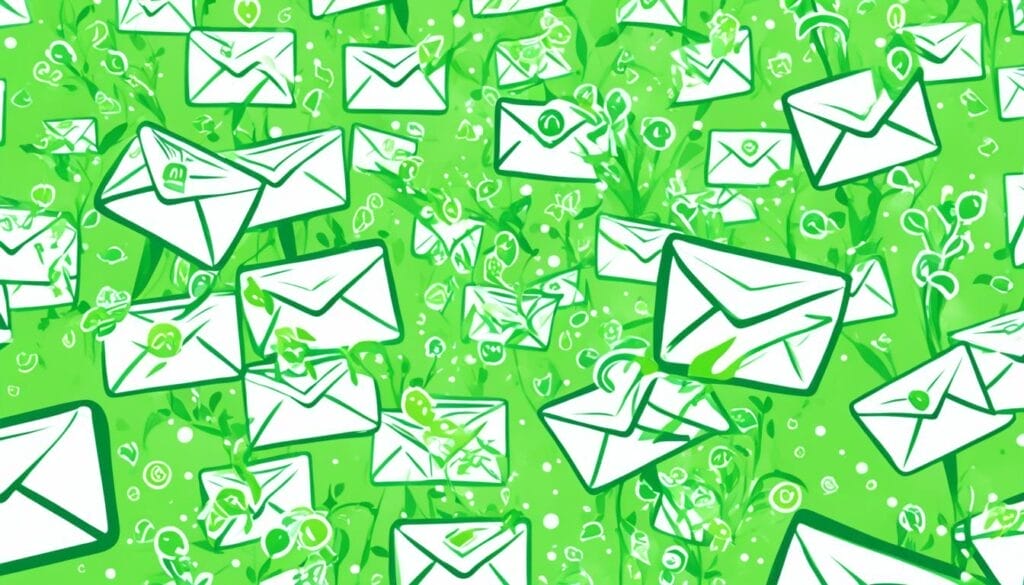Did you know that lead nurturing boosts sales-ready leads by 50% at a lower cost? Email lead nurturing is changing the game for businesses. It helps build relationships with potential customers and moves them closer to buying.
Let’s dive into the power of email lead nurturing. We’ll share strategies and email lead nurturing techniques to get really good at this key marketing skill.
Key Takeaways:
- Email lead nurturing can generate 50% more sales-ready leads at a lower cost.
- Lead nurturing involves building relationships with potential customers at every stage of the marketing and sales funnels.
- Personalised communication, valuable content, and leveraging social proof are key elements of successful lead nurturing campaigns.
- Implementing lead nurturing best practices and utilising CRM software can greatly enhance the effectiveness of email lead nurturing techniques.
- Continuous monitoring, analysis, and optimisation are crucial for maximising the results of lead nurturing efforts.
What is Lead Nurturing?
Lead nurturing is about developing relationships with buyers from start to finish. It focuses on what buyers need and want, giving them useful information. This helps guide them towards making a buy.
It all begins in the marketing stage, even before leads turn into actual customers. It then follows through the sales process. This process helps businesses gain the buyer’s trust, increase the value of a customer over time, align their sales and marketing teams, and educate their customers better.
It’s more than just pushing for a sale. It’s about forming connections and giving something valuable. When businesses offer personalised advice, they connect with leads in a deep and meaningful way. This builds loyalty in the long run.
Lead nurturing is a thoughtful method. It’s about understanding what every lead wants and needs. It means tailoring how you talk to them. This way, a strong and helpful relationship is built for both sides.
“Lead nurturing is about building relationships, not just making sales. It’s about guiding leads. Giving them the support and info they need to decide smartly.”
– Paul Nightingale, Lead Gen Expert
The Benefits of Lead Nurturing
For businesses, lead nurturing is a must-do. It helps maximise marketing and sales. Here are the major perks:
- Building Relationships: It helps form trust and credibility. This leads to having loyal customers.
- Increasing Customer Lifetime Value: Businesses can boost sales and up-selling. This gets more value from each customer.
- Improving Sales and Marketing Alignment: It smooths the handover between marketing and sales. They both work better together, aiming to convert leads into customers.
- Enhancing Customer Education: It helps educate customers. Using personalised communication, it teaches them about products or services. This makes them smarter customers.
Lead nurturing works well for all kinds of businesses. When businesses focus on nurturing leads, they support their journey to making a purchase. This leads to more sales and success in the long term.
The Power of Email in Lead Nurturing
Email marketing is key for nurturing leads. Businesses use emails to share useful content and introduce their brand. They create personalised email campaigns to connect with potential buyers at different points.
The best emails start with a catchy subject line. Then, they offer information that meets the needs of the reader. It’s all about personalisation. This means using the reader’s name and crafting content that matches their interests.
Adding images and videos makes emails more interesting. It also helps to include clear actions for the reader to take. This could be to download something, join a webinar, or buy a product.
“Lead nurturing emails provide valuable content, familiarise leads with the brand, and help build relationships.”
When writing emails, use the company’s look and a warm hello. The main part should be convincing, explaining what you offer. A neat signature with your contact info adds a personal note.
Allowing email sharing and making it easy to unsubscribe are also important. This helps spread the word and respects people’s choices.

You can set up emails to send automatically with CRM software like Convertrr. This makes sure leads get the right info at the right time. It boosts your chances of turning leads into customers.
Email Marketing Statistics
Here are some stats that show how strong email marketing is for nurturing leads:
- Lead nurturing emails generate an 8% CTR (click-through rate)
- Personalised email campaigns improve conversion rates by 10%
- Email marketing has an ROI of 4200%
- Segmented email campaigns result in a 760% increase in revenue
These figures prove how effective email marketing is. They show why it’s vital for any lead nurturing plan.
Strategies for Successful Lead Nurturing
Lead nurturing involves using special tactics to turn leads into loyal customers. These email lead nurturing techniques and strategies help build strong connections and increase sales. They provide businesses with the chance to grow by deepening relationships.
Email Campaigns: Consistent Communication
Consistently sending emails to leads is a key strategy. This keeps them interested in your business. Using personal touches makes your emails more effective. It helps your leads see the value in what you offer.
Social Proof: Leveraging Customer Experiences
“Displaying positive feedback from customers can greatly help in building trust. It showcases the value of your service or product to others.”
Showing testimonials and reviews gives leads confidence in your brand. Social proof is a powerful tool for making people trust you.
Valuable Content: Blogs and Webinars
Sharing important content through blogs and webinars is crucial. It shows your expertise to leads. Addressing their main concerns grabs their attention.
This makes them more likely to trust you. They see your brand as a reliable source of information.
Marketing Automation: Streamlining the Process
“Using automated tools can make your campaigns more efficient. It ensures leads get timely and relevant information.”
Automation simplifies the process by handling repetitive tasks. It lets you engage with leads better. This can lead to more conversions.
Segmentation: Personalised Communication
Organising leads into groups helps send more targeted messages. This personalises how you communicate with them. It makes them more likely to respond. They feel you understand their needs.
Monitoring and Optimisation: Continuous Improvement
It’s important to keep an eye on your campaigns and make them better. Looking at key numbers can guide you. It shows you what works and where you can do better.
Improving and learning over time helps you succeed. These methods, along with other strategies, can really make a difference in your lead nurturing.
Importance of Lead Nurturing in B2B and B2C Contexts
Lead nurturing is vital in both B2B and B2C worlds. For B2B, it means building trust and knowledge with educational info. Consistent, valuable talks with potential clients are a must.
Showing off happy customers and good reviews boosts brand confidence. Offering free trials lets leads try products or services without risk. Tailoring messages to solve specific problems is key.
For B2C, it’s all about connecting on an emotional level. Storytelling and personal communication help. Using customer feedback in nurturing and offering special deals builds loyalty.
Successful lead nurturing means knowing your audience well. Adapting B2B or B2C strategies to meet their needs improves results. Every business has to find its own way to engage and convert leads.
| Business Sector | B2B Lead Nurturing | B2C Lead Nurturing |
|---|---|---|
| Technology | Focus on showcasing expertise, providing technical resources, and addressing pain points specific to businesses. | Create emotional connections through personalised communication, relatable stories, and exclusive consumer offers. |
| Healthcare | Highlight industry expertise, thought leadership, and case studies to build credibility and trust with healthcare providers. | Develop trust through transparent and informative content, personalised interactions, and fostering emotional connections. |
| E-commerce | Offer product demos, free trials, and show the value of the product or service in a B2B context. | Create engaging content, leverage user-generated reviews and recommendations, and provide exclusive discounts and offers. |
Best Practices for Effective Lead Nurturing Emails
There are key best practices for making lead-nurturing emails that really work. These tips will help you make your email campaigns stand out. You’ll see more leads turning into customers.
Personalisation: Adding a Personal Touch
Personalisation makes a big difference in emails. It’s about using your lead’s name and matching content to what they like. This makes your emails more meaningful. You can make this personal touch automated with personalisation tokens.
Delivering Valuable Content: Providing Relevant Information
Give your leads something they find useful and interesting. Every email should offer something they need or want. Whether it’s a how-to guide, insider info, or a special deal, this approach shows you’re a valuable source of information.
“Deliver content of genuine value that addresses your leads’ pain points and solves their problems.”
Clear Calls to Action: Guiding Leads Towards Conversion
Have a clear action you want your leads to take. This could be signing up for something, getting a demo, or buying a product. Make these actions clear and easy to follow. Use words that urge quick action.
Segmenting Leads: Targeted Communication
Dividing your leads into groups lets you send more relevant messages. This leads to better interaction and more conversions. Also, you can trigger emails based on your leads’ actions. This keeps your communication timely and personal.
Timing and Frequency: Finding the Right Balance
Sending emails at the right time and not too often is tricky. Too many emails can put people off and too few can make them forget you. Test different timings and see what works. This helps you find the right balance for your audience.
Testing and Optimisation: Improving Email Performance
To make your emails better, keep testing and tweaking them. Try different subject lines, designs, and content. Look at the data to see what’s working and make changes based on that.
Seamless User Experience: Mobile Compatibility and Design
Today, everyone uses their mobiles for emails. Make sure your emails look good and work well on all devices. Eye-catching designs and clear content will help keep your leads interested.

Always check how your emails are doing. Using analytics helps you understand what’s working. By following these best practices, your emails can be more effective. You’ll connect better with your audience and lead them towards buying from you.
Exploring Different Types of Email Sequences
Email sequences help nurture leads, moving them towards becoming customers. They allow businesses to tailor messages for specific lead goals and stages. Let’s look at some common types of nurturing sequences:
Welcome Sequences
Welcome sequences are key for new leads. They introduce the brand warmly and show its value. This aims to start a great relationship with the lead.
Educational Sequences
These sequences provide valuable content to leads. They position the brand as an expert in the industry. Blogs, whitepapers, and webinars help build trust and credibility.
Re-engagement Sequences
For leads who’ve lost interest, there are re-engagement sequences. They aim to spark interest again. This is done through special offers or personalised content.
Feedback Sequences
Feedback sequences let leads share their thoughts. They help businesses improve their products and services. Surveys and ratings provide valuable insights for better customer experiences.
Every email sequence should match the lead’s journey and goals. This lets businesses effectively guide leads towards making a purchase.

| Sequence Type | Objective | Key Features |
|---|---|---|
| Welcome Sequences | Introduce brand Set the tone for future communications | Warm welcome Highlights brand value |
| Educational Sequences | Position brand as authority Provide valuable content | Informative resources Build credibility |
| Re-engagement Sequences | Revive interest Encourage re-engagement | Personalised content Exclusive offers |
| Feedback Sequences | Collect insights Improve products and services | Surveys, ratings Enhance customer experience |
By using each email sequence wisely, businesses can make a strong lead nurturing plan. This helps leads move towards buying and builds lasting relationships with customers.
Summing It Up
Email lead nurturing helps build relations with possible customers. Using good techniques, businesses can boost sales, loyalty, and get more leads ready to buy.
Tailoring emails is key in making lead nurturing work. When emails meet the leads’ needs, a real bond forms. Sharing useful content, like articles, shows expertise and gains trust.
Showing off good reviews and success stories makes the brand more trustworthy. This public proof can really affect buying choices and enhance the relationship. Also, using tools for automated marketing makes it easier to stay in touch.
Keeping an eye on how things are going and making tweaks is crucial. Businesses need to always check performance and make smart changes. This way, they can make their lead nurturing efforts more effective and successful in the long run.
FAQ
What are email lead nurturing techniques?
Email lead nurturing is about building relationships with possible customers. This is done through emails that are personalised and offer useful content. The goal is to help them decide to buy from you.
How does lead nurturing work?
It starts by understanding what the leads need. Then, you give them information that is useful and relevant. The aim is to lead them to make a purchase smoothly.
Why is email important in lead nurturing?
Email is key because it allows for direct and personalised communication. It also helps in providing valuable content which builds relationships. Plus, it guides leads through the buying process in a way that’s engaging to them.
What are some effective lead nurturing strategies?
Great strategies include sending regular emails. You should personalise these emails and use social proof. It’s also good to give out valuable content in blogs and webinars. Lastly, using automation can make the process smoother.
Is lead nurturing important in both B2B and B2C contexts?
Absolutely, it’s crucial in both B2B and B2C worlds. For B2B, it’s about proving expertise and credibility. In B2C, it creates emotional connections and offers personalised messages.
What are some best practices for effective lead nurturing emails?
The right practices are personalisation and providing valuable content. Also, use clear calls to action to guide what the leads should do. It’s important to segment your leads and decide when and how often to send the emails. Always test and make your emails better.
What are different types of email sequences used for lead nurturing?
There are various sequences. These include welcomes, educational emails, those to re-engage, and asking for feedback. Each type has its own goals and helps the lead at different stages of their journey.
Source Links
- https://www.lyntonweb.com/inbound-marketing-blog/5-factors-to-consider-when-building-a-lead-nurturing-campaign
- https://www.zendesk.com/blog/ultimate-guide-lead-nurturing/
- https://www.activetrail.com/marketing_blog/email_marketing_articles/mastering-lead-nurturing-a-comprehensive-approach-to-elevating-your-business/





